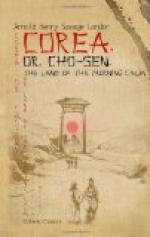More interesting to me than the temples and buildings were the bonzes, who are, I may as well say at once, a very depraved lot. It is a strange fact in nature that the vicious are often more interesting than the virtuous. So it is with the Corean bonzes. Here you have a body of men, shrewd, it is true, yet wicked (not to say more) and entirely without conscience, whose only aim is to make money at the expense of weak-minded believers. Morals they have none; if it were possible, one might say even less than none. They lead a lazy and vicious life in these monasteries, gambling among themselves and spending much time in orgies. They feed themselves well at the expense of the charitable, and a great deal of their energy is expended in blackmailing rich persons, not of course openly, but through agents as disreputable as themselves. Whenever there are riots or revolutions in progress, their origin can invariably be traced to the monasteries. In other respects, excepting these few little faults, they seemed charming people. Their dress consists of a long white padded gown with baggy sleeves; the usual huge trousers and short coat underneath; and a rosary of largeish beads round their necks. When praying, the rosary is held in the hands, and each bead counts for one prayer. A larger bead in the rosary is the starting-point. When petitions are being offered to Buddha on behalf of third parties—for rarely do they, if ever, pray on behalf of themselves—there is a scale of prices varying according to the wealth of the petitioners; so many prayers are worth so much cash; in other words, one buys them as one would rice or fruit. The bonzes shave their heads as clean as billiard balls; while the novices content themselves with cutting their hair extremely short, leaving it, probably, not longer than one-eighth of an inch. There are many different degrees of bonzes. We have, for example, the begging bonzes, who wear large conical hats of plaited split bamboos, or else hats smaller still and also cone-shaped but made of thick dried grass. They travel all over the district, and sometimes even to distant provinces, collecting funds and information from the people. Sometimes they impose their company on some well-to-do person, who, owing to the Corean etiquette in the matter of hospitality, has to provide them with food, money and promises of constant contributions before he can get rid of them. Then there are the stay-at-home bonzes, well-fattened and easy-going, who cover their heads with round, horse-hair, stiffened black caps of the exact shape of those familiar articles in French and Italian pastry-cook shops, used over the different plates to prevent flies from eating the sweets. Lastly, we have the military priests, who follow the army to offer up prayers when at war and during battles, and who don hats of the ordinary shape worn by every one else except that they have round crowns instead of almost cylindrical ones. These alone are occasionally allowed to enter the towns. Paper sandals are the foot-gear chiefly in use among them.




